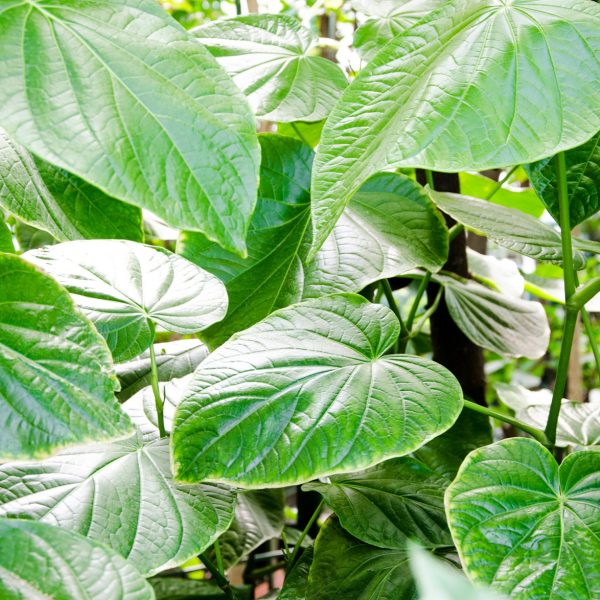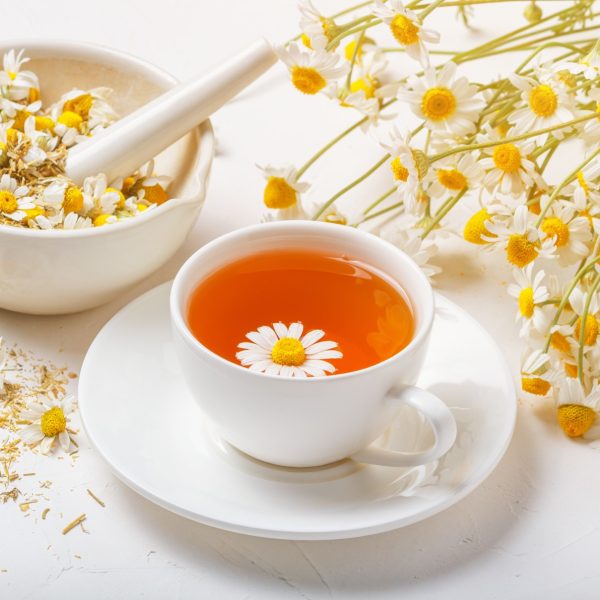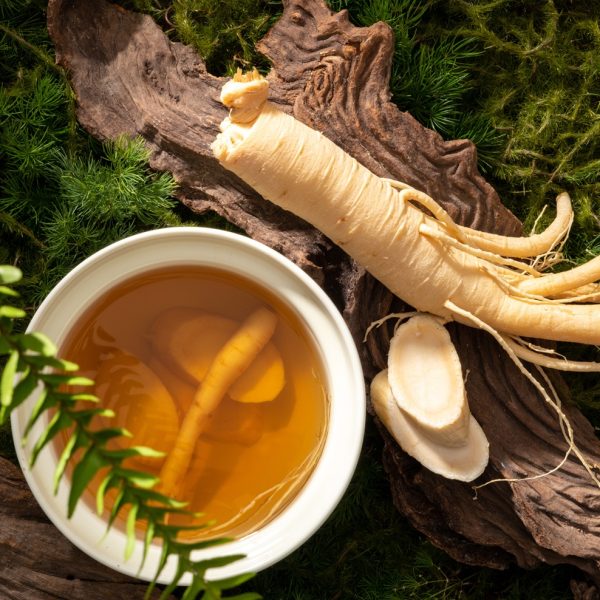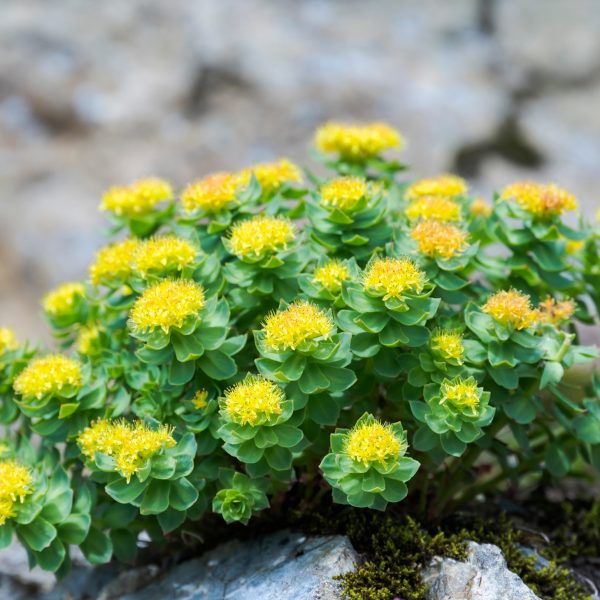-
How does it feel?
Bai shao has a somewhat bland, slightly sour and bitter taste, the latter owing to its major constituent paeoniflorin, a monoterpene glycoside. The sourness, according to the classics, allows it to ‘enter the tendons and the liver’. In the hand, prepared bai shao is pleasing to hold; smooth with a soft, powdery feel, reminding one of its ability to soften, smooth and harmonise on both a physical and emotional level.
-
What can I use it for?
 Bai shao’s primary actions are to tonify Blood and ‘soften’ the Liver. In TCM, the Liver is responsible for storing blood, supplying blood to the Uterus and regulating the smooth flow of qi (and, thus, Blood and emotions). It is, therefore, integral to menstrual function and physiology and bai shao, being such an excellent tonic and liver support, is indispensable for conditions relating to menstrual health and a chief herb in cases of absent periods or period pain where blood deficiency has led to stagnation and pain.
Bai shao’s primary actions are to tonify Blood and ‘soften’ the Liver. In TCM, the Liver is responsible for storing blood, supplying blood to the Uterus and regulating the smooth flow of qi (and, thus, Blood and emotions). It is, therefore, integral to menstrual function and physiology and bai shao, being such an excellent tonic and liver support, is indispensable for conditions relating to menstrual health and a chief herb in cases of absent periods or period pain where blood deficiency has led to stagnation and pain.In TCM, the Liver governs the tendons. Where blood is deficient, the muscles and tendons lack nourishment and contraction and pain ensue. Bai shao, with its wonderful analgesic, anti-inflammatory and sedative properties, is a primary herb for nourishing Liver blood to alleviate this type of cramping, spasmodic pain. Aside from period pain, bai shao also excels in treating pain in the flank, chest, abdomen (including dysenteric cramps), calves, hands and feet.
Entering both the Liver and Spleen, bai shao exerts its harmonising effect on this organ relationship. When Liver qi stagnates, as it so readily does in modern life, it can impact our digestion (Spleen/ Stomach) causing abdominal cramping and diarrhoea. Bai shao is a principle herb in addressing digestive issues, with their root in Liver qi constraint.
While categorised as a blood tonic, bai shao is also an important yin tonic. In particular, Liver yin. Liver yin acts as an anchor for Liver yang which, if unrestrained, becomes ascendant leading to symptoms such as pressure headaches, hypertension, dizziness, tinnitus and agitation. Bai shao has a lovely sedating action on the Liver; strengthening Liver yin to descend and quell irascible Liver yang.
Being a sour and, therefore, astringent herb, bai shao is also used in cases of irregular sweating such as spontaneous daytime sweats and night sweats. These can be from effulgent yang qi, deficient yin qi or an imbalance of the ying and wei qi – the interior, nourishing and exterior, defensive qi, respectively. When these lose harmony, the opening and closing of the pores is affected and improper sweating can occur. This astringent quality also makes it a common choice for conditions such as abnormal vaginal discharge or bleeding and involuntary ejaculation.
-
Into the heart of bai shao
 Bitter, sour and cool in nature, bai shao tonifies, harmonises, sedates and astringes to alleviate a wide range of ailments. Specifically, it nourishes the Blood, tonifies and preserves yin, regulates the menses, calms the liver and curbs Liver yang, harmonises ying and wei qi and stops pain.
Bitter, sour and cool in nature, bai shao tonifies, harmonises, sedates and astringes to alleviate a wide range of ailments. Specifically, it nourishes the Blood, tonifies and preserves yin, regulates the menses, calms the liver and curbs Liver yang, harmonises ying and wei qi and stops pain.While numerous constituents have been isolated from the Paeonia lactiflora root, the primary component is paeoniflorin, a widely researched monoterpene glycoside. It is likely that some of bai shao’s many actions and applications may be attributable to paeoniflorin, which has demonstrated sedative, antispasmodic, anti-inflammatory, antipyretic, antioxidant, immunomodulatory, anti-neoplastic, anti-hyperglycaemic and neuroprotective effects.
It has also been found to contain phytoestrogens and decrease testosterone levels, going some way to explain its ability to regulate the menses and ease symptoms of the menopause.
-
Traditional uses
 The peony plant has been cultivated and coveted for the great beauty of its blooms for thousands of years. The lords of Henan province in central China gave peony flowers as offerings to their king almost 4,000 years ago.
The peony plant has been cultivated and coveted for the great beauty of its blooms for thousands of years. The lords of Henan province in central China gave peony flowers as offerings to their king almost 4,000 years ago.In its long history as a medicinal substance, bai shao has had many faces. Historically, it has been used as a tonifying, thickening and flavouring agent in cooking (Confucius claimed himself a fan), a ritual fasting aid for its ability to stabilise blood sugar and as a therapy for toxicity from food and drink (an application used in early Daoist alchemical practices where it was used to protect against heavy metal poisoning).
Bai shao was first listed in the Shennong Bencao Jing (The Divine Farmer’s Materia Medica) (ca. 100 A.D.) as a bitter medicinal for treating ‘evil qi’, abdominal pain, blood stasis, masses, urinary difficulty and qi deficiency. It is also believed to have been used medicinally by the ancient Greeks and was, up to the 19th Century, featured in the European Pharmacopoeia.
-
Traditional actions
Herbal actions describe therapeutic changes that occur in the body in response to taking a herb. These actions are used to express how a herb physiologically influences cells, tissues, organs or systems. Clinical observations are traditionally what have defined these actions: an increase in urine output, diuretic; improved wound healing, vulnerary; or a reduction in fever, antipyretic. These descriptors too have become a means to group herbs by their effects on the body — herbs with a nervine action have become the nervines, herbs with a bitter action are the bitters. Recognising herbs as members of these groups provides a preliminary familiarity with their mechanisms from which to then develop an understanding of their affinities and nuance and discern their clinical significance.
-
Traditional energetic actions
Herbal energetics are the descriptions Herbalists have given to plants, mushrooms, lichens, foods, and some minerals based on the direct experience of how they taste, feel, and work in the body. All traditional health systems use these principles to explain how the environment we live in and absorb, impacts our health. Find out more about traditional energetic actions in our article “An introduction to herbal energetics“.
Western energetics
-
What practitioners say
 Menstrual
MenstrualBai shao is an instrumental TCM herb for regulating menstruation. It may, and often is, used at any stage of the menstrual cycle, but is most important in the follicular phase (the yin half of the cycle; menstruation and post-menstruation) where it helps to supplement and support Blood and yin during and after the period when they and naturally depleted. It is also useful to include in the second half of the cycle (the yang phase; ovulation and pre-menses) in cases of Liver qi and Blood stagnation, where its harmonising and sedating effects are drawn on to address conditions such as anovulation from hyperprolactinemia and PMT.
It is often used for absent, light, irregular (both late and early) or painful periods and bleeding between periods. Accompanying symptoms indicating bai shao for use in these instances will tend to be those of Liver Blood deficiency (dry skin, hair and nails, tingling in the limbs, insomnia, blurred vision, pale tongue, thin pulse) with or without the often consequent Liver qi stagnation (period pain that is paired with a pale tongue and thin pulse tells us that this particular qi stagnation is a result of blood deficiency). It is also often used in formulas where heat from ongoing Liver qi stagnation or yin deficiency has led to the ‘reckless’ movement of blood such as that seen in bleeding between the periods and early periods.
Bai shao is also invaluable (with the appropriate pattern of symptoms) for helping issues that plague women at the time of their periods, including breast distension, headaches, diarrhoea, fever and skin outbreaks.
Musculoskeletal
Any pain – in particular, abdominal, chest or flank pain – that is cramping and contracting in nature and due to Blood deficiency or qi stagnation will lend itself to this herb. For this purpose, it is often combined with gan cao (Licorice). Indeed, the formula Shao Yao Gan Cao Tang is simply bai shao and gan cao combined in equal parts to treat a vast array of pain conditions (everything from sciatic pain to bronchial spasms) and is especially useful for cramps in the calf muscles.
Gynaecological
Bai shao is indicated in any number of gynaecological conditions where its abilities to tonify Blood and yin, calm the Liver, stop pain and astringe are required. These can include endometriosis, pelvic inflammatory disease, abdominal masses and excessive vaginal discharge.
Reproductive
Bai shao is used as a supportive medicinal and often prescribed in formulas where a woman’sfertility issues are believed to be linked to underlying patterns of Blood deficiency, Blood stagnation, qi stagnation and/ or Liver and Kidney yin deficiency. It is also included in formulas for men experiencing fertility issues such as low sperm count and quality, erectile dysfunction related to Kidney deficiency or qi and Blood stagnation.
Obstetric
Given for morning sickness where Liver qi invades the Stomach, abdominal pain from Blood deficiency (a common condition in pregnancy), Liver qi stagnation or Cold, edema from qi stagnation and dizziness from Liver yang rising. Post-partum, where qi, Blood and yin deficiencies are very common, bai shao is readily included in formulae for post-natal depression, abdominal pain, constipation and absent or insufficient lactation.
 Digestive
DigestiveA primary herb for treating abdominal pain owing to the Spleen/ Stomach (digestion) being ‘attacked’ by errant Liver qi. This is a common clinical presentation (think, IBS) and occurs where emotional issues (notably, anger, stress, resentment or pent-up emotions) have led to Liver qi stagnation which has then gone wayward. It often occurs against a backdrop of weak digestion, which allows the invasion to occur and, therefore, treatment involves supporting Earth (Spleen/ Stomach) while controlling Wood (Liver). To this end, bai zhu (white Atractylodes) will typically be combined with bai shao to nourish Earth and control Wood, respectively. Also used in cases of dysenteric pain.
Nervous
Used for headaches, dizziness and insomnia from either Blood or yin deficiency or Liver yang rising. Calms irritability from ascendant Liver yang and nourishes Blood and calms the Liver, generally, to alleviate tension, depression and mood swings. In western herbalism, bai shao is used for epilepsy and spasms. Research has explored bai shao’s neuroprotective potential – as seen in Parkinson’s disease, for which it is a chief herb – attributing it to a reduction in neuroinflammation.
Immune
Bai shao’s antiinflammatory and immunmodulatory properties lend it to use in a range of inflammatory autoimmune conditions such as rheumatoid arthritis and systemic lupus erythematosus.
Cardiovascular
Used as an antihypertensive in Western herbalism, bai shao is also included in TCM formulas to descend Liver yang in cases of high blood pressure.
Skin
Bai shao is used for spontaneous day or night sweats from deficient yin and excessive Liver yang. It also regulates sweating in cases of wind-cold (colds and flu) where sweating has failed to alleviate symptoms because of an underlying deficiency. In such case it will be combined with gui zhi (Cinnamon) to harmonise the ying and wei qi. This combination is also used in formulas to treat skin conditions, such as itching and hives, caused by wind-cold trapped in the body’s exterior. As a yin and Blood tonic, bai shao may also be used to treat skin conditions with yin and Blood deficiency at the root, including chronic dryness, itching, carbuncles, dermatitis and lupus.
-
Research
 Research into the use of bai shao tends to focus on the water/ethanol extract TGP (total glucosides of Peony) of which paeoniflorin is the major constituent. While further large scale randomized control tests are needed to explore bai shao, TGP and paeoniflorin’s therapeutic benefits, the following pre-clinical in vivo trials have yielded promising results.
Research into the use of bai shao tends to focus on the water/ethanol extract TGP (total glucosides of Peony) of which paeoniflorin is the major constituent. While further large scale randomized control tests are needed to explore bai shao, TGP and paeoniflorin’s therapeutic benefits, the following pre-clinical in vivo trials have yielded promising results.Paeoniflorin has shown anti-inflammatory and immunosuppressive actions in a large number of studies yet the exact mechanisms of which are not clearly understood.
In a review of twelve trials exploring the mechanisms behind TGP’s anti-inflammatory and immunomodulatory activity, it was concluded that TGP inhibits the production of inflammatory mediators and proinflammatory cytokines. In other studies, the same review also determined that TGP may dampen heightened immune responses by inhibiting lymphocyte proliferation, balancing the differentiation of T helper and T suppressor cells and increasing lymphocyte apoptosis. TGP was also found to protect cells against oxidative stress. Anti-inflammatory effects were also seen in a recent study into using white peony root for cholestasis.
In a study looking in to the potential neuroprotective qualities of white peony root, it was found that the TNF signalling pathway was a key pathway for its therapeutic effects and that it inhibited neurodegeneration by reducing neuroinflammation, slowing neural apoptosis and regulating neurotransmitter levels.
In a later study, TGP decreased oxidative stress and protected against neurotoxicity by reducing the absorption of toxic alkaloids into the brain. Neuroprotective, along with anti-depressant effects, were also observed in another recent study.
TGP’s analgesic effect was verified in numerous studies where it was found, in part, to involve adenosine A1 receptor and not opiate receptors.
In a recent review of TCM use for menopausal hot flushes, bai shao was found to be the most commonly prescribed individual herb, likely owing to it containing phytoestrogens and displaying phytoestrogenic effects.
-
Did you know?
Another important TCM herb, chi shao (red peony root), is derived from the root of Paeonia lactiflora. By leaving the red skin of the root on, the function changes to make it slightly colder and, therefore, better at clearing heat as in cases of Blood heat and Liver fire. It also has the ability to invigorate Blood. Where bai shao treats pain from deficiency and qi stagnation, chi shao eases pain from Blood stagnation. They are often used together to complement and enhance their effects.
Additional information
-
Botanical description
The white peony plant is a herbaceous perennial from the Ranunculaceae family. Reaching 60-100cm tall, it has
broad, dark green compound leaves and is cultivated the world over for its incredibly beautiful, large, full flowers
of pink and white hues.Traditionally gathered in the wild during Summer or Autumn from the rocky slopes, woodland edges and
riverbanks of its native soils (south-east Siberia to north and east China) the root of the white peony plant is now largely cultivated in agricultural regions of mainland China. In particular, Zhejiang, Anhui, Sichuan, Guizhou and Shandong provinces. While the best bai shao is believed to hail from Zhejiang, most of today’s peony root comes from Bozhou, Anhui, where the variety can be harvested after just two year’s growth (as opposed to the traditional 4-5 years) and without the trimming of side roots typically required after the first year of growth.Once harvested, the roots are cleaned, stripped of their skin, boiled, dried and sliced. These are then prepared in a variety of ways to enhance or regulate their effects, notably: dry-fried (chao bai shao) to warm its energetic temperature making it less cooling on the digestion and fried with vinegar (cu chao bai shao) to increase its analgesic and liver-soothing effects.
-
Common names
- White peony root
- Chinese peony root
- Bai shao/bai shao yao (Mandarin)
- Bhyakushaku (Japanese)
- Paekchak (Korean)
-
Safety
Because of its cool nature, use with caution in individuals with weak yang qi and in diarrhoea from deficient cold. Incompatible with li lu (Veratrum root and rhizome).
-
Interactions
Caution is advised in combination with blood thinning medications
-
Contraindications
Due to its effects upon the female reproductive system it is best to avoid use during pregnancy and lactation.
Because of its cool nature, use with caution in individuals with weak yang qi and with diarrhoea from deficient cold. Incompatible with Li Lu (Veratrum root and rhizome).
-
Preparations
Traditionally, soaked in water for at least 20-30 minutes then decocted in non-metallic pots in a formula of two or more herbs on a low-moderate heat for around 20-30 mins. Nowadays, also prepared in powder and tincture form.
-
Dosage
Dried or powdered herb: 6-15g – very large doses may be up to 30g.
Liquid extract (1:2): weekly dose – 25-75 ml
Tincture (1:3 25%): Take 2-4ml three times daily.
-
Plant parts used
Root
-
Constituents
- Paeoniflorin
- Paeonol
- Paeonin
- Albiflorin
- Triterpenoids
- Sistosterol

-
Habitat
This plant is from the rocky slopes, woodland edges and riverbanks of its native soils (south-east Siberia to north and east China) the root of the white peony plant is now largely cultivated in agricultural regions of mainland China, in particular, Zhejiang, Anhui, Sichuan, Guizhou and Shandong provinces.
-
Sustainability
The IUCN Red List of Threatened Plants database doe not yet include endangered rating for this plant.
-
Quality control
Herbal Medicines are often extremely safe to take, however it is important to supply herbal medicines from a reputed supplier. Sometimes herbs bought from unreputable sources are contaminated, adulterated or substituted with incorrect plant matter.
Some important markers for quality to look for would be to look for certified organic labelling, ensuring that the correct scientific / botanical name is used.
A supplier should also be able to tell you where the herbs have come from. There is more space for contamination and adulteration where supply chain is unknown.
-
How to grow
- Peony is bought as potted plants or as bare-root plant. Growing Peony from seed can take around 3- 5 years, however it is doable.
- Best in a deep, fertile, humus-rich soil that is moist but well-drained in a sheltered position in full sun or partial shade. Peony is long-lived but resents disturbance.
- Bare-root peony plants should be planted as soon as they arrive.
- Peonies are best planted in autumn or spring. Ensure you don’t plant them too deeply, as this will yield poor results.
- Mix in plenty of well-rotted organic matter before planting.
- Apply a balanced fertiliser in spring.
- NOTE: Avoid overwatering newly planted peonies as this is a common cause of plant failure.
-
Recipe
Herbal Soup for the premenstrual phase
This soup helps to alleviate constraint and promote the downward flow of qi and blood in preparation for menstruation.
Servings: 6 (1 per day)
Ingredients:
- 1 oz. bai shao
- 1 oz. corn silk
- ½ cup of sheng jiang pi (fresh ginger peel)
- ½ oz. chuan xiong (Ligisticum rhizome)
- ½ cup of pearl barley
- 6 cups vegetable/ chicken stock
- 1 cup of chopped parsley
- 1 cup diced radish
- 1 sliced carrot
- 1 whole sliced leek
- ¼ cup of sweet vinegar
Method:
- Place corn silk and sheng jiang pi in muslin bag
- Simmer all of the herbs and pearl barley in the stock for 1 hour
- Add the vegetables and simmer for 15 mins more
- Remove the muslin bag, add the vinegar and serve
Note: not to be consumed if pregnancy has or may have occurred. Caution with significant pre-menstrual heat signs.
Source: Beinfield H, Korngold E. Between Heaven and Earth: A Guide to Chinese Medicine. New York: Ballantine Books; 1991.



























 Bai shao’s primary actions are to tonify Blood and ‘soften’ the Liver. In TCM, the Liver is responsible for storing blood, supplying blood to the Uterus and regulating the smooth flow of qi (and, thus, Blood and emotions). It is, therefore, integral to menstrual function and physiology and bai shao, being such an excellent tonic and liver support, is indispensable for conditions relating to menstrual health and a chief herb in cases of absent periods or period pain where blood deficiency has led to stagnation and pain.
Bai shao’s primary actions are to tonify Blood and ‘soften’ the Liver. In TCM, the Liver is responsible for storing blood, supplying blood to the Uterus and regulating the smooth flow of qi (and, thus, Blood and emotions). It is, therefore, integral to menstrual function and physiology and bai shao, being such an excellent tonic and liver support, is indispensable for conditions relating to menstrual health and a chief herb in cases of absent periods or period pain where blood deficiency has led to stagnation and pain. Bitter, sour and cool in nature, bai shao tonifies, harmonises, sedates and astringes to alleviate a wide range of ailments. Specifically, it nourishes the Blood, tonifies and preserves yin, regulates the menses, calms the liver and curbs Liver yang, harmonises ying and wei qi and stops pain.
Bitter, sour and cool in nature, bai shao tonifies, harmonises, sedates and astringes to alleviate a wide range of ailments. Specifically, it nourishes the Blood, tonifies and preserves yin, regulates the menses, calms the liver and curbs Liver yang, harmonises ying and wei qi and stops pain. The peony plant has been cultivated and coveted for the great beauty of its blooms for thousands of years. The lords of Henan province in central China gave peony flowers as offerings to their king almost 4,000 years ago.
The peony plant has been cultivated and coveted for the great beauty of its blooms for thousands of years. The lords of Henan province in central China gave peony flowers as offerings to their king almost 4,000 years ago. Menstrual
Menstrual Research into the use of bai shao tends to focus on the water/ethanol extract TGP (total glucosides of Peony) of which paeoniflorin is the major constituent. While further large scale randomized control tests are needed to explore bai shao, TGP and paeoniflorin’s therapeutic benefits, the following pre-clinical in vivo trials have yielded promising results.
Research into the use of bai shao tends to focus on the water/ethanol extract TGP (total glucosides of Peony) of which paeoniflorin is the major constituent. While further large scale randomized control tests are needed to explore bai shao, TGP and paeoniflorin’s therapeutic benefits, the following pre-clinical in vivo trials have yielded promising results.





